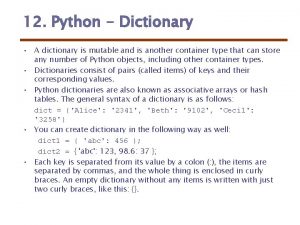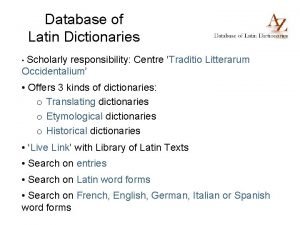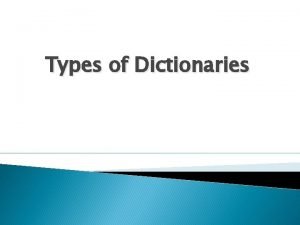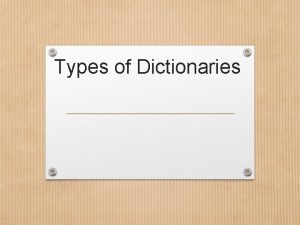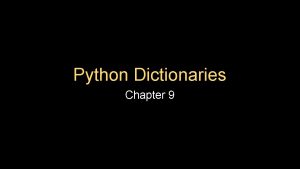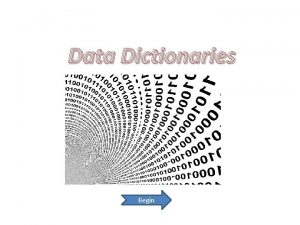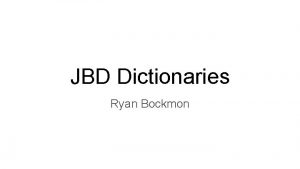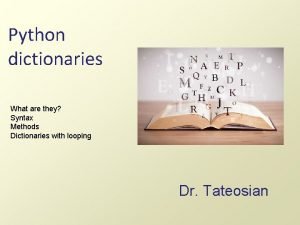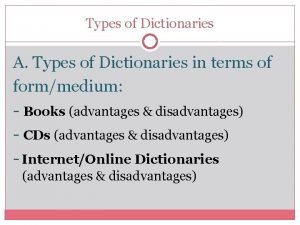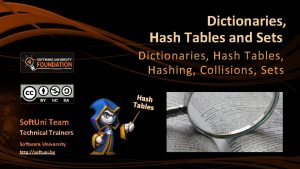Dictionaries 6 2 1 11242020 9 4 Dictionaries












- Slides: 12

Dictionaries 6 < 2 1 11/24/2020 9 > 4 = Dictionaries 8 1

Outline and Reading Dictionary ADT (§ 2. 5. 1) Log file (§ 2. 5. 1) Binary search (§ 3. 1. 1) Lookup table (§ 3. 1. 1) Binary search tree (§ 3. 1. 2) n n Search (§ 3. 1. 3) Insertion (§ 3. 1. 4) Deletion (§ 3. 1. 5) Performance (§ 3. 1. 6) 11/24/2020 Dictionaries 2

Dictionary ADT The dictionary ADT models a searchable collection of keyelement items The main operations of a dictionary are searching, inserting, and deleting items Multiple items with the same key are allowed Applications: n n n address book credit card authorization mapping host names (e. g. , cs 16. net) to internet addresses (e. g. , 128. 148. 34. 101) Dictionary ADT methods: n n n 11/24/2020 Dictionaries find. Element(k): if the dictionary has an item with key k, returns its element, else, returns the special element NO_SUCH_KEY insert. Item(k, o): inserts item (k, o) into the dictionary remove. Element(k): if the dictionary has an item with key k, removes it from the dictionary and returns its element, else returns the special element NO_SUCH_KEY size(), is. Empty() keys(), Elements() 3

Log File A log file is a dictionary implemented by means of an unsorted sequence n We store the items of the dictionary in a sequence (based on a doubly-linked lists or a circular array), in arbitrary order Performance: n n insert. Item takes O(1) time since we can insert the new item at the beginning or at the end of the sequence find. Element and remove. Element take O(n) time since in the worst case (the item is not found) we traverse the entire sequence to look for an item with the given key The log file is effective only for dictionaries of small size or for dictionaries on which insertions are the most common operations, while searches and removals are rarely performed (e. g. , historical record of logins to a workstation) 11/24/2020 Dictionaries 4

Binary Search Binary search performs operation find. Element(k) on a dictionary implemented by means of an array-based sequence, sorted by key n n n similar to the high-low game at each step, the number of candidate items is halved terminates after a logarithmic number of steps Example: find. Element(7) 0 1 3 4 5 7 1 0 3 4 5 m l 0 9 11 14 16 18 19 m l 0 8 1 1 3 3 7 h 8 9 11 14 16 18 19 h 4 5 7 l m h 4 5 7 l=m =h 11/24/2020 Dictionaries 5

Lookup Table A lookup table is a dictionary implemented by means of a sorted sequence n n We store the items of the dictionary in an array-based sequence, sorted by key We use an external comparator for the keys Performance: n n n find. Element takes O(log n) time, using binary search insert. Item takes O(n) time since in the worst case we have to shift n/2 items to make room for the new item remove. Element take O(n) time since in the worst case we have to shift n/2 items to compact the items after the removal The lookup table is effective only for dictionaries of small size or for dictionaries on which searches are the most common operations, while insertions and removals are rarely performed (e. g. , credit card authorizations) 11/24/2020 Dictionaries 6

Binary Search Tree A binary search tree is a binary tree storing keys (or key-element pairs) at its internal nodes and satisfying the following property: n Let u, v, and w be three nodes such that u is in the left subtree of v and w is in the right subtree of v. We have key(u) key(v) key(w) An inorder traversal of a binary search trees visits the keys in increasing order 6 2 1 9 4 8 External nodes do not store items 11/24/2020 Dictionaries 7

Search Algorithm find. Element(k, v) To search for a key k, if T. is. External (v) we trace a downward return NO_SUCH_KEY path starting at the root if k < key(v) The next node visited return find. Element(k, T. left. Child(v)) depends on the else if k = key(v) outcome of the return element(v) comparison of k with else { k > key(v) } the key of the current return find. Element(k, T. right. Child(v)) node 6 If we reach a leaf, the < key is not found and we 2 9 > return NO_SUCH_KEY 8 Example: 1 4 = find. Element(4) 11/24/2020 Dictionaries 8

Insertion To perform operation insert. Item(k, o), we search for key k Assume k is not already in the tree, and let w be the leaf reached by the search We insert k at node w and expand w into an internal node Example: insert 5 6 < 2 9 > 1 4 > w 6 2 1 9 4 8 5 11/24/2020 8 Dictionaries w 9

Deletion To perform operation remove. Element(k), we search for key k Assume key k is in the tree, and let v be the node storing k If node v has a leaf child w, we remove v and w from the tree with operation remove. Above. External(w) Example: remove 4 2 Dictionaries 9 > 4 v 1 w 8 5 6 2 1 11/24/2020 6 < 9 5 8 10

Deletion (cont. ) We consider the case where the key k to be removed is stored at a node v whose children are both internal n n n we find the internal node w that follows v in an inorder traversal we copy key(w) into node v we remove node w and its left child z (which must be a leaf) by means of operation remove. Above. External(z) Example: remove 3 11/24/2020 1 3 v 2 8 6 w 5 z 1 5 v 2 8 6 Dictionaries 9 9 11

Performance Consider a dictionary with n items implemented by means of a binary search tree of height h n n the space used is O(n) methods find. Element , insert. Item and remove. Element take O(h) time The height h is O(n) in the worst case and O(log n) in the best case 11/24/2020 Dictionaries 12
